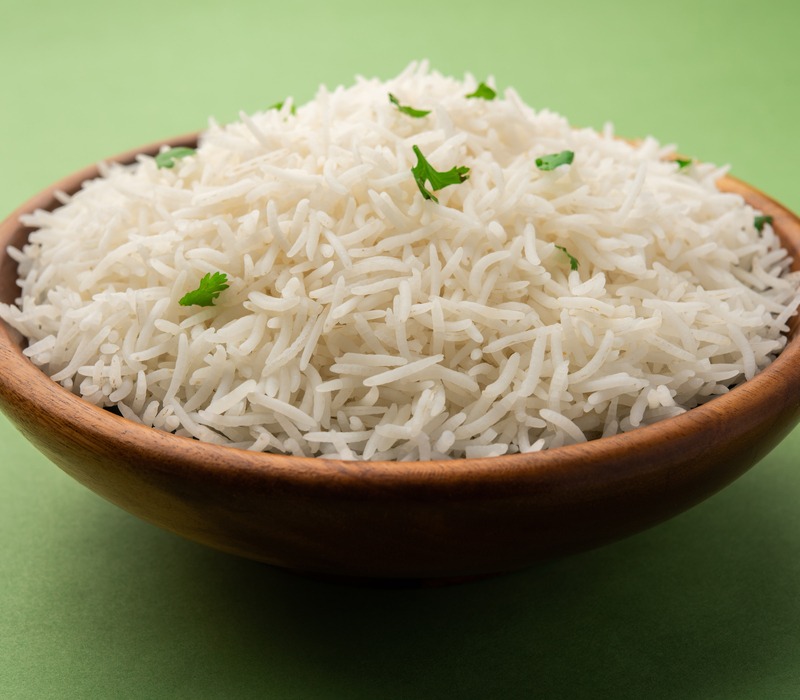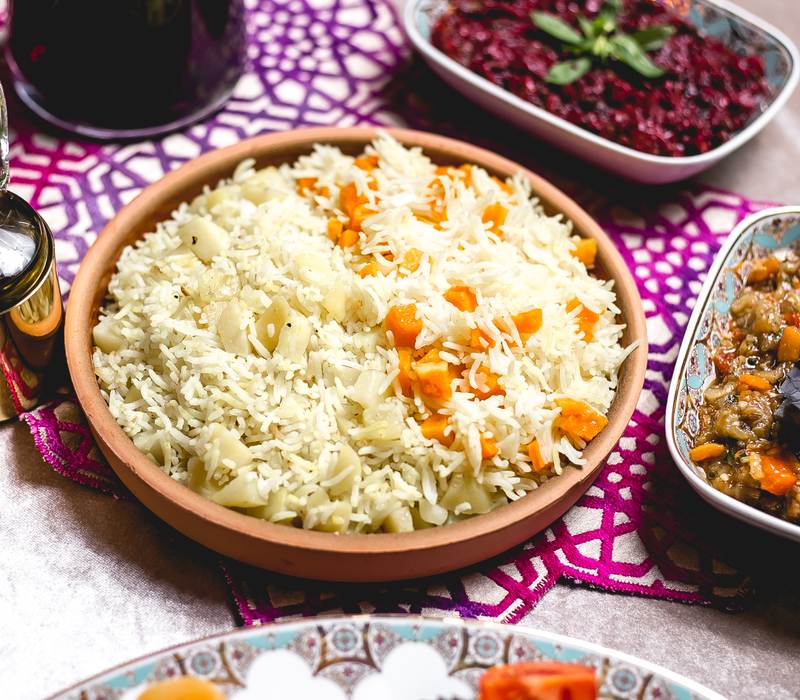While rice is inherently gluten-free, couscous is derived from whole wheat flour and is the starchy seed of cereal grass. Both of these primary meals are high in carbs, however, rice is a grown crop, whilst couscous is a man-made product akin to pasta.
But before that, you’ll have to understand the difference between rice and couscous.
if you love couscous then try these recipes “Greek Couscous Salad“, “5 Best Vegan Couscous Recipes“, and “Chicken and Couscous“.
Page Contents
What Is Couscous?
The ingredients for couscous, a form of pasta, are water and semolina wheat flour. Couscous is a flexible food because of its mild nutty flavor, which may be paired with fruits, vegetables, and meats to form a delicious main meal or side dish.

The short cooking time of couscous is one of its most notable features. Golden Couscous cooks in about 5 minutes, whereas Traditional Pearl Couscous takes 15 minutes to prepare.
Where Does Couscous Come From?
Middle Eastern cuisine known as couscous is said to have originated during the 12th and 13th centuries. It was first rolled by hand when it was first made.
Even while some chefs still like this approach, machines are being used more frequently. A large portion of the couscous sold in grocery shops is described as “instant” or “rapid cooking” and is prepared by boiling.
Couscous is prepared in Morocco, Algeria, and Tunisia by steaming it over a simmering stew only after it has been combined with a little water and oil.
Couscous Nutritional Info
| Nutrients Name | Amount per (100 gms) | % Daily Value |
|---|---|---|
| Calories | 112 | |
| Total Fat | 0.2 gm | 0% |
| Saturated Fat | 0 gm | 0% |
| Cholesterol | 0 mg | 0% |
| Sodium | 5 mg | 0% |
| Potassium | 58 mg | 1% |
| Total Carbohydrate | 23 gm | 7% |
| Dietary Fiber | 1.4 gm | 5% |
| Sugars | 0.1 gm | |
| Protein | 3.8 gm | 7% |
| Vitamin C | 0 gm | 0% |
| Iron | 2% | |
| Vitamin B6 | 5% | |
| Magnesium | 2% | |
| Calcium | 0% | |
| Vitamin D | 0% | |
| Cobalamin | 0% |
What Is Rice?
Different types of rice include white rice, brown rice, and basmati rice. Some are in fact different varieties of rice, while others are just treated in a different way. But regardless of the variety you choose to eat, rice is a grain, just like wheat.

So, from whence does rice originate? Your familiar rice is grown on a rice plant, which is a kind of grass. Rice plants come in two varieties: Oryza glaberrima and Oryza sativa.
These two species provide a wide range of rice varietals with various tastes and textures.
Where Does Rice Come From?
Although it is thought that rice originated in China, rice dishes have been prepared all over the world for ages in areas like India and Africa.
Rice has been a staple meal in culture for thousands of years. This Rice preparation differs greatly by area, having a significant impact on both flavor and presentation.
Rice Nutritional Info
| Nutrients Name | Amount per (100 gms) | % Daily Value |
|---|---|---|
| Calories | 130 | |
| Total Fat | 0.3 gm | 0% |
| Saturated Fat | 0.1 gm | 0% |
| Cholesterol | 0 mg | 0% |
| Sodium | 1 mg | 0% |
| Potassium | 35 mg | 1% |
| Total Carbohydrate | 28 gm | 9% |
| Dietary Fiber | 0.4 gm | 1% |
| Sugars | 0.1 gm | |
| Protein | 2.7 gm | 5% |
| Vitamin C | 0 gm | 0% |
| Iron | 1% | |
| Vitamin B6 | 5% | |
| Calcium | 1% | |
| Vitamin D | 0% | |
| Cobalamin | 0% |
How healthy is Rice Compared to Couscous?
Less than 3g of fat per 100g of uncooked rice makes rice low in fat, and like other grains like wheat, rice is a rich source of carbohydrates, which provide the body with energy.
Its gluten-free status, in contrast to couscous, makes it ideal for those with celiac disease or gluten intolerance. There are several varieties, but because it contains a lot of fiber, brown rice is particularly nourishing.
Choose low-GI rice from the list above if you are managing high blood sugar levels or diabetes. Couscous should be avoided in favor of lower GI barley, buckwheat, bulgar, and quinoa.
Health Benefits of Rice
Rice Helps in Providing Energy
Rice contains a lot of carbs, which provide the body with enough energy and support optimal brain function. The body must digest carbohydrates before they can be converted to useful, usable energy.
The functioning and metabolic activity of all organ systems in the body are enhanced by the vitamins, minerals, and numerous organic components found in rice, which further boosts energy levels.
Rice Aids in Blood Pressure Management
Since rice contains less salt, it is regarded as one of the greatest foods for those with hypertension and high blood pressure.
Because sodium may narrow veins and arteries, the cardiovascular system is put under more stress and strain when blood pressure rises.
Avoiding too much salt is always a good option because it is linked to cardiac diseases like atherosclerosis, heart attacks, and strokes.
Red yeast rice for blood pressure is also used by people to reduce blood pressure. Brown rice and whiter rice are helpful for high blood pressure patients.
Rice Skin Care Benefits
Additionally utilized in skin care products are black rice, brown rice, rice bran oil, and rice water. According to medical professionals, rice powder can be administered topically to treat several skin conditions.
Ayurvedic doctors in India frequently recommend rice water as an efficient ointment to calm down irritated skin surfaces. The phenolic chemicals that are present, especially in rice, have anti-inflammatory characteristics, making them useful for reducing inflammation and irritability.
A chemical produced from rice usually relieves a variety of skin diseases, whether it is taken or used topically. Additionally, the antioxidant included in rice helps prevent wrinkles and other early indications of aging that can impact the skin.
Rice is Good for Irritable Bowel Syndrome
Resistant starch, which enters the colon in an undigested state, is abundant in rice. This kind of starch promotes the development of beneficial bacteria that aid in regular bowel motions.
Irritable Bowel Syndrome (IBS) and diarrhea are two ailments that this insoluble rice is highly effective in easing. For irritable bowel syndrome, either white rice or brown rice can be consumed.
Rice Assists in Preventing Recurrent Constipation
Chronic constipation can also be avoided by eating rice. The insoluble fiber in rice behaves like a supple sponge that may be readily and swiftly pushed through the digestive tract.
Whole grains like rice are well recognized for having high insoluble fiber content. However, in addition to consuming fiber meals, it is advised to drink a lot of water to treat constipation.
Rice Helps to Regulate Body Temperature
Rice water is the water used to boil rice during the cooking process. When rice is cooked at a high temperature it contributes starch to the water, which is why rice water is present.
Body temperature may be controlled by rice water. Thus, drinking rice water helps to reduce fever and maintains body temperature. As a result, rice can be used to treat feverish persons.
Health Benefits of Couscous
Improves Digestive Health
Cooked couscous contains fewer calories and carbs per cup than brown rice and white rice combined. Compared to white rice, couscous contains more fiber.
But with 3 grams of fiber per cup, brown rice comes out on top. Fiber promotes intestinal health and might lengthen your feeling of fullness after meals. These nutritional advantages could aid in your quest for and maintenance of a healthy weight.
Regular couscous is not a substantial source of whole grains or fiber because it is produced from processed semolina.
However, you may get couscous prepared with whole-grain flour.
Energy Boosting Carbohydrates as a Source
The body prefers to get its energy from carbs. To enhance training and recuperation, active people should add even more carbs to a balanced diet.
Choose whole-grain couscous if you can get it since around half of your daily grain consumption needs to come from whole grains.
Weight Loss Support
Couscous’ low-calorie content, which makes it a good dietary item, is perhaps its best-known feature. Grain products are frequently the answer for dieters seeking calorie-free versions of their favorite foods.
They have few calories, are quick to prepare, and are satisfying. When it comes to grains, couscous is really preferable to rice and quinoa since each cup has fewer than 200 calories.
This amounts to less than 10% of the recommended daily calorie intake for individuals. As a result, it’s the ideal alternative for those who want to lose weight mostly by dieting.
However, the additional protein that couscous offers also makes it a potent booster for muscular growth.
Additionally, couscous has very low levels of salt, cholesterol, and saturated fat, all of which are detrimental to attempts to lose weight.
Antibacterial Properties
Few individuals are aware that couscous may strengthen the immune system. It works well as an antiviral and antibacterial agent. The herpes virus, cancer cells, cold sores, and shingles are all effectively repelled by it.
Including couscous in your diet promotes both healthy eating and overall wellness. It may have previously appeared hard to switch your preferred pasta and rice for low-calorie versions without compromising flavor.
However, there is now a technique to transform your subsequent meal into a tasty, healthful hit.
FAQs- Couscous Rice
Because rice and couscous are cooked and utilized similarly, you may swap one out for the other. Additionally, they both take on the taste of any sauces or seasonings you may use.
Although couscous is a form of pasta and rice is a grain, whole-grain versions of each are available.
Although neither item is thought to be low in carbohydrates, they do have certain peculiarities. Couscous typically has a somewhat lower carbohydrate content per serving compared to brown and white rice.
The amount of carbs is the same between our Traditional Pearl Couscous and our Wild and Brown Rice Mix, however.
Conclusion– Couscous Rice
Because rice and couscous are cooked and utilized similarly, you may swap one out for the other. Additionally, they both take on the taste of any sauces or seasonings you may use.
Although couscous is a form of pasta and rice is a grain, whole-grain versions of each are available. Brown rice and whole-wheat couscous will provide you with more fiber than white rice and normal couscous, so plan accordingly.
Here are a few more related articles that you might like.

